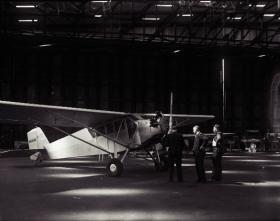Wrong way Corrigan
Published in 20th-century / Contemporary History, General, Issue 5 (Sep/Oct 2008), News, Volume 16
‘Wrong Way’ Corrigan’s 1929 Curtiss Robin OX-5 monoplane in the hanger at Baldoyle aerodrome after his ‘accidental’ non-stop solo flight from New York in July 1938. The photograph is part of the ‘Trains, Planes and Automobiles’ exhibition at the National Photographic Archive, Temple Bar, Dublin, which runs until the end of October 2008. (National Library of Ireland)
It was a flight that he claimed was ‘accidental’ that earned him the nickname ‘Wrong Way’ Corrigan, as well as a ticker-tape parade in New York, a Hollywood movie about his life and a best-selling book. Born on 22 January 1907, Douglas Corrigan won first prize in a local baby contest at the tender age of fifteen months, but his first taste of aviation came in October 1925, when he saw people riding a ‘Jenny’ biplane. A week later he paid for a ride himself, and a life-long love was born.
After qualifying as a pilot he got a job in San Diego building the legendary Spirit of St Louis, and actually pulled the chocks away when Lindbergh flew it to New York in preparation for his historic solo transatlantic flight. Inspired, Corrigan decided that he too would fly across the Atlanic to his father’s homeland in Ireland—even if he couldn’t get official permission.
By 1928 Corrigan was working as a mechanic in St Louis, and doing aerobatic stunts for flying students during his lunch breaks. After earning his transport pilot’s certificate, he returned to the West Coast and in 1933 spent $310 on a second-hand 1929 Curtiss Robin OX-5 monoplane. He installed bigger engines and extra fuel tanks, then applied to the Bureau of Air Commerce for permission to make a non-stop flight from New York to Ireland in 1935. It was the first of many rejections, and he was only authorised for cross-country flights.
Corrigan was determined, however, and on 9 July 1938 he once again left California in his plane Sunshine, bound for New York. Ignoring a fuel leak problem, he took off early in the morning a few days later from the Floyd Bennett Field in Brooklyn. He later claimed that his intention was to fly back to California but that poor visibility owing to fog and a faulty compass made him fly east rather than west. True or not, he just kept going and landed at Baldonnel airfield, outside Dublin, 28 hours and 13 minutes later on 18 July 1938. All he had on board were two chocolate bars, two boxes of fig bars and a quart of water; he had no radio, his compass was decades old, and the extra fuel tanks meant that he could only see out of the sides of the plane—but he had made it.
Despite breaking the rules, Corrigan only received a mild punishment—his pilot’s certificate was suspended for two weeks—and close to a million people attended his Broadway ticker-tape parade when he returned to New York. Fame and fortune quickly followed. He published his autobiography, That’s my story (the phrase he used to justify his ‘accidental’ flight), and endorsed a number of products—including a watch that ran backwards—before starring as himself in RKO’s The Flying Irishman, a Hollywood movie based on his life. He was even referenced by the Three Stooges in their 1938 short Flat Foot Stooges, and in The Rocky and Bullwinkle Show the character Captain Peter ‘Wrong Way’ Peachfuzz was the world’s worst sailor.
During World War II Corrigan tested bombers, and he retired in 1950. Tragedy touched his life in 1972 when one of his sons died, ironically, in a plane crash. Nevertheless, in 1988 he joined in the golden anniversary celebrations, allowing enthusiasts to retrieve the famous Curtiss Robin plane from his garage. Sunshine was still airworthy, and Corrigan was so enthusiastic that the organisers considered attaching the tail to a police car in case this senior citizen decided to relive his glory days!
Douglas ‘Wrong Way’ Corrigan died in 1995 and was buried at Fairhaven Memorial Park in Santa Ana. Aviation historians today regard him as an accomplished mechanic and pilot who had the courage to fly across the Atlantic when few dared—accident or not.
James Bartlett is a writer and journalist living in Los Angeles.


















